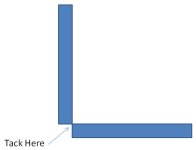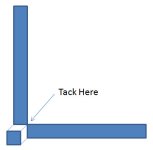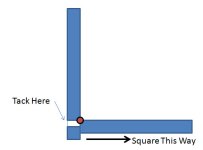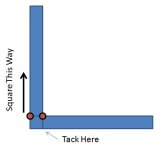I've been doing some work on a small welding table, and had some ideas about how to help make sure it's square. The table is mostly made of 2" square tubing. For the top, to make sure it ended up square, I realized that I could easily put tacks as shown below, allowing them to act as a hinge and allowing me to make final adjustments to the angles before welding the legs into the corners.

Getting the legs square in both directions was a little challenging. I came to see that the order the tacks were put in was critical. If the tack is put in on the inside of a joint, then the joint can hinge inwards on the tack without breaking the tack, but if you were to pull outwards, it would break the tack. The opposite would be true if the tack was put on the outside of the joint. What I finally ended up with was this.

If the vertical leg is perfectly square, then don't bother with this silliness, but since it probably isn't perfectly square, rotate it so that it angles outwards rather than angling inwards in any direction. Then tack the inside corner. This tack location allows the leg to hinge inward in both directions.

Next square up the leg in one direction and, holding it square, tack the opposing outside part of the joint. The two existing tacks now hold the leg square in the one direction, while creating a hinge that can be easily bent inwards in the remaining direction.

Finally, square up the leg in the remaining direction and tack the opposing outside part of the joint. These three tacks should now hold the leg square to the frame. If the leg is not square in any direction, simply grind out the opposing tack, leaving the remaining two tacks to act as hinges while you square it up.
Hope this made sense, and I'm definitely receptive to any feedback on alternative or improved methods of accomplishing the desired outcome. Obviously, this is a problem that has been well solved by fabricators through the years, and I'm certainly reinventing the wheel. This is the inevitable consequence of not getting formal training.



